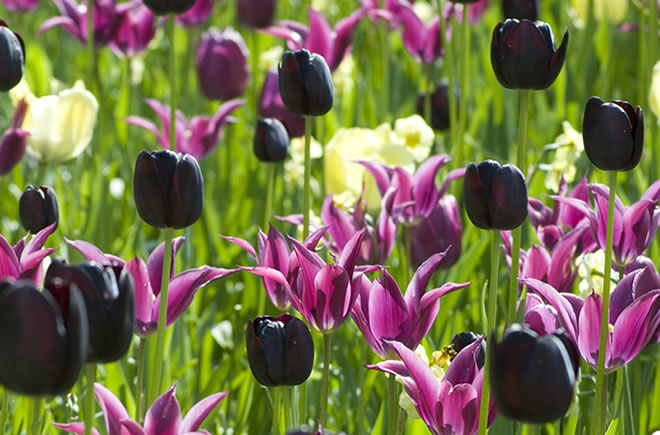
Different Kinds Of Tulips

There are various groups of Tulips, each with their own, specific characteristics. The group classification system developed as growers introduced more and more new shapes and forms over over the past few centuries. Eventually, fifteen different groups were set, based on factors such as shape, heritage (who were the ancestors) and flowering season.
Group 1: Single Early
Selections in this group have relatively large, round flowers on short (up to 40cm / 16in) stems with neat foliage. As they are shorter than many other Tulips, many are ideal for pots. Their flowering period starts around the first week of April. Examples in this group: ‘Christmas Dream’, ‘Couleur Cardinal’, and ‘Princess Irene’.
Group 2: Double Early
These double-flowered Tulips are shorter and a little later than the single-flowered group. They are excellent in containers as their flowers are long-lasting. Examples in this group: ‘Peach Blossom’, ‘Monte Carlo’, and ‘Abba’.
Group 3: Triumph
These are robust, mid-season flowering Tulips (flowering in April). Originating from hybrids of early (Group 1) and late (Group 5) cultivars, they are among the most disparate of the groups, varying from compact, rounded flowers to those with a longer, almost flared shape. All have sturdy stems, reaching a height of 40 – 50cm (16 – 20in). Examples in this group: ‘Don Quichotte’, ‘Gavota’, ‘Negrita’, and ‘Shirley’.
Group 4: Darwin Hybrid
This mid-season group (flowering in April) originated from hybrids of Darwin Tulips and various species, particularly Tulipa Fosteriana. They have long-lasting, large flowers on tall stems up to 60cm / 24in, and are better in borders than in pots. Examples in this group: ‘Ad Rem’, ‘Daydream’, and ‘Parade’.
Group 5: Single Late Group
A large group with relatively small, rounded flowers on stiff stems up to 60cm / 24in tall. May flowering. ‘Queen of Night’, the near-black Tulip, belongs here, as well as ‘Maureen’, ‘Menton’ and ‘Sorbet’.
Group 6: Lily-flowered
These slender, beautifully waisted flowers have pointed tips to the petals that flare outwards. They are among the most graceful and recognizable of Tulips. They vary in height, but are normally 50 – 60cm high (20 – 24in) and flower mid-season to mid-late-season (from late April and into May). The most well-known varieties are ‘Ballade’, ‘Ballerina’ and ‘White Triumphator’.
Group 7: Fringed
Appealing fringed Tulips are a newer development in Tulip breeding, and many are variations of well-known cultivars. Officially, they are mid-flowering to late-flowering Tulips (end of April to the beginning of May). They are characterized by petal edges that are crystallized or crimped. Their heights vary from 40 – 60cm (16 – 24in). ‘Blue Heron’, ‘Maja’ and ‘Red Hat’ belong to this group.
Group 8: Viridiflora
When they open, the color of the flowers in this group is almost entirely green, and gradually a second base color appears. They vary in height between 30 – 50cm (12 – 20in). Their flowering period is late (May) and the flowers are long-lasting. Examples in this group: ‘China Town’, ‘Artist’ and ‘Spring Green’.
Group 9: Rembrandt
This group includes famous flamed or ‘broken’ Tulips. Sadly, their intricate patterns are due to being infected with the ‘Tulip breaking virus’, which, while creating beautiful patterns, can ruin a strand in the longer term. As this disease can be spread to other Tulips, these bulbs are mainly kept in historic collections or grown by specialist societies. A very well known cultivar is ‘Zomerschoon’.
Group 10: Parrot.
These distinctive Tulips are single-flowered and have distorted petals that are deeply cut, curled or twisted into often amazing shapes. They are usually late flowering (May), variable in height and ‘flamed’ in one or more colours. Their height is 40 – 60cm (16 – 24in). Well known parrots are ‘Black Parrot’, ‘Rococo’ and ‘Estella Rijnveld’.
Group 11: Double Late
The blooms of these showy flowers are more rounded than those of the early doubles (group 2), and they are usually much taller. They flower in May. Examples in this group: ‘Angélique’, ‘Wirosa’ and ‘Orange Princess’.
Group 12: Kaufmanninana.
These are short (10 – 25cm / 4 – 10in), very early flowering Tulips (March), sometimes with mottled foliage and often bi-colored flowers that open flat. Since they resemble water lilies, they are also called ‘waterlily Tulips’. Examples in this group: ‘Showwinner’, ‘Heart’s Delight’ and ‘Concerto’.
Group 13: Fosteriana
These are early flowering Tulips (from late March) with broad, green or grey-green leaves and large flowers. Their height varies from 25 – 40cm / 10 – 16in. Well-known cultivars are ‘Purissima’, ‘Orange Emperor’ and ‘Sweetheart’.
Group 14: Greigii
These are low-growing (20 – 30cm / 8 – 12in) Tulips with distinctive mottled or striped foliage that often spreads on the ground. The flowers are relatively large with short, sturdy stems and their flowering period is early, in the first week of April. Well known cultivars are ‘Red Riding Hood’, ‘Pinocchio’ and ‘Toronto’.
Group 15: Miscellaneous
This group is a collection of species with a wide range of varieties and cultivars that do not belong to any previous group. The variety of height and flowering period is larger in this group than any other. However, for the most part, these are low growing, small-flowered Tulips with a delicate charm. Among the best and most well-known ones are ‘Tulipa Turkestanica’, ‘Tulipa Clusiana’ and cultivars, ‘Tulipa Batalinii Bright Gem’, ‘Tulipa Tarda’ and ‘Tulipa Sylvestris’.

